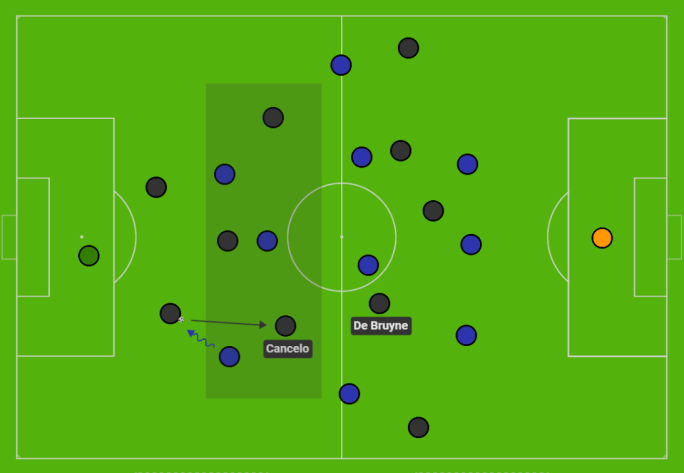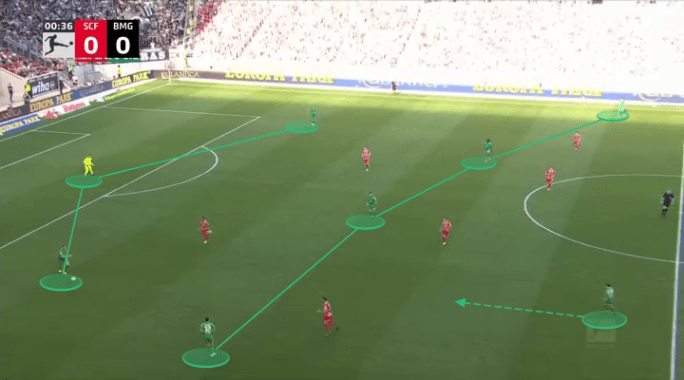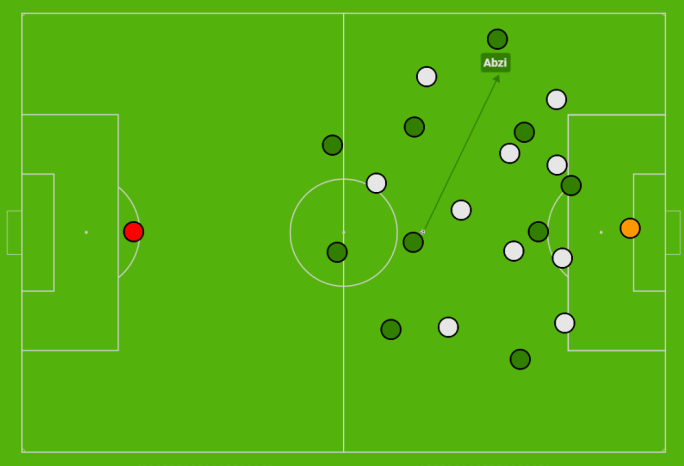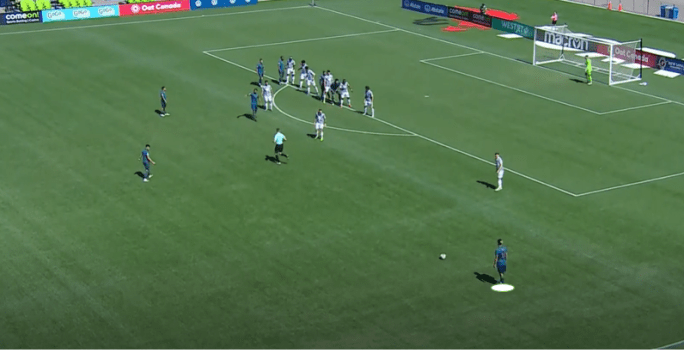Trying to capture everything imaginable when watching a football match remains an impossible endeavour. But simultaneously, trying to capture absolutely nothing beyond the first glance won’t necessarily yield great results in your task to remember important information and events. You’ve probably heard it before as professors lamented your lack of note taking in university, but you are far more likely to remember information if you take the time to write it down. Your distracted brain already has a million other things to focus on, and if you don’t take the time to write down your thoughts, the chances of allowing a thought to go from short-term to long-term memory becomes less by the second.
Embed from Getty ImagesNot only that, but note taking allows you to sharpen your thoughts, allowing you to think about the complexities of football on a deeper level. While making notations, you will not only be able to remember the “what”, but begin to think more deeply about the “why”. As someone trying to understand the nature of the game on a deeper level (which you are), note taking is an essential skill. So as part of our Introduction to Football Analysis course, I’m going to be teaching you my entire process of taking notes from start to finish.
CREATING CATEGORIES
Embed from Getty ImagesThe easiest way to start taking notes on a football match is to develop pre-designed categories of play that you want to witness. Like Anthony Taylor above, you want to separate the blue from the yellow, and take each in isolation. For a team analysis, you could categorize the team’s performance into the different thirds/phases of the game. For example: “Build-up” could be a separate category on your page from “Creation”. However, that presents issues in trying to fit everything in within the space you allot (particularly if you’re writing notes by hand). It also means you spend time scanning for your categories, rather than scanning for match events as they unfold.
Embed from Getty ImagesI can’t tell you how many times I’ve had to rewind the play or seek out highlights later, because I missed something on first glance. It will happen even when you’re watching carefully, and it will happen all the more when you’re scribbling away, head down, lost in a thought.
So instead of deeply detailed categorizations, I often split my analysis up between ‘In Possession’ and ‘Out of Possession’. Simplifying this process, I will title the sections ‘In P’ and ‘Out of P’. As I’ll come to discuss, short-forming words becomes an essential facet of notations, allowing you to pay less attention to the writing, and more attention to the football.
If attempting to watch two teams simultaneously, say for purposes of a ‘Match Analysis’, I may even just create separate classifications for the two teams, without separating any phases of the game. This makes my thoughts more jumbled when trying to follow-up by writing any type of analysis, but the trade-off is in simplifying the process in the moment.
WHAT TO NOTE

When making notes on a football match, it’s important to first understand your context. What are you watching the match for? Do you plan on doing a follow-up analysis? Are you gathering information across several matches to be used in the distant future? Are you testing your knowledge in the quest to learn more? Knowing the answer to this question will allow you to scan for information most applicable for your purposes.
For my purposes, I watch football matches for all of the reasons above, but the primary goal is to take notes that will aid my analyses. I know that when I do an eventual analysis of a team or player, I’ll want to discuss aspects of their play from build-up to progression to creation, all the way over to how they engage in a high-block, mid-block and low-block. As a bonus, I may even want to note facets of transitional play and set-pieces. I therefore want to understand information that occurs between the thirds and ensure I’m noting any differences that occur between those phases of play.

Saying that a team defends in a 4-4-2 formation might be correct across all three phases, but rarely will a team fail to change their shape from high-block to low-block. It’s therefore important not only to note the “what”, but the “where”. For example, Napoli defend in a 4-4-2 mid-block, but their high-block is more likely to become 4-2-3-1. Their low-block may tighten to 4-5-1 or 4-4-1-1 to compact the spaces across the pitch. These are important distinctions to make.
I also want to make sure I’m taking notes on valuable and important information that pertains to future analysis, rather than arbitrary information on refereeing decisions, who’s hot and who’s not, or single-instance examples that don’t transform into actual patterns. The one exception to that last one would be in a Match Analysis, where single-instance events can become more relevant to the single-instance context at hand. But that information becomes significantly less relevant when assessing the over-arching schemes behind a team’s tactics, or a player’s ability.
So when it comes to assessing and scanning for patterns of play, I’m looking for the over-arching structures, shapes, quirks and player abilities that occur between the phases of the game. I’m not necessarily concerned about whether the ideology is novel or commonplace in the grander scheme of football, just that it exists within the realms of the team’s plans, and occurs over time. As an example, a 2+3 build-up is something you might encounter in any football match you watch this weekend. It’s particularly common-place among teams that play in a back-four; and the goalkeeper will often join in a diamond shape to support a centrally focused quartet, that then allows the team to expand the width of the field via the full-backs. This may not be unique to a team like Arsenal Women or Manchester City, but it’s still worth noting as I assess their style of play in the build-up.

Beyond the over-arching shapes and structures behind a team’s master-plan, I also want to understand who on the team injects variety and difference. I’m therefore looking for the attackers that inject the most attacking thrust, the defenders capable of pulling off impressive long passes or switches of play, and how different players perform under pressure or in moments of intense scrutinization. But again, this information becomes irrelevant if it can’t be backed up by other instances of the same feat. Statistics can then be used even in the moment to fact-check thoughts as they manifest, such as through live football statistics websites like FotMob and WhoScored. But remember – context is key in making sweeping claims behind a player’s ability, or the statistics they accumulate.
Embed from Getty ImagesOut of all positions on a pitch, goalkeepers will frequently rank the highest on short pass completion. Knowing this information without understanding the context, you’d be forgiven for thinking that there is something innate in the training of goalkeepers that allows them to complete short passes to tremendous effect. In reality, the vast majority of their short passes come under little to no pressure, and at moments where picking out a pass becomes easier due to the positioning of their mates and the opposition. A short pass made on goal kicks for example is often made from a distance of three to five yards away to a player that has a 100% guaranteed success rate of receiving the ball, due in large part to a rule that imposes opposition players to start outside of the box.
Embed from Getty ImagesOpposition players also tend not to be bothered by goalkeepers picking up possession in the build-up (such as that 2+3 diamond we discussed), even if they relentlessly press recycles of play to the keeper in other moments of the game. The context around the situation will always allow for greater understanding, and a fully fleshed out idea behind your observations.
Hopefully this longwinded explanation gives you plenty of context into the overarching idea here. You must make note of ball, opposition, teammates and space when thinking about the game. Without this greater context, it becomes incredibly difficult to fully encapsulate accurate information.
TAKING NOTES WITHOUT TAKING AWAY FOCUS
Embed from Getty ImagesOne of the greatest challenges of a note-taker is to not simultaneously take away their focus from the live in-the-moment elements of a match. This becomes a particular challenge when watching a match live in stadium, with no ability to pause or freeze-frame the game. The game goes on without the analyst’s permission, and so you must select your moments to write wisely. But recognizing what we’ve already spoken about regarding short-term memory, it then becomes quite the task to simultaneously remember thoughts and flesh them out all the more, without taking away the focus. The best time to take notes, just like the best time to coach and make interventions in a training session, is when the ball goes out of play. Stoppages, substitutions, goal kicks and set-pieces offer you a few extra seconds to develop your thoughts without taking the focus away from the situation as it unfolds.
When watching matches live in stadium, I also like to disappear at half-time and find a quiet section of the stadium to detail my thoughts over a voice-note. This allows me to nicely summarize events that occurred throughout the half together as one, rather than the scattered nature of note-taking that takes place across the entire half. Here’s an example of a half-time audio recording made during this match.
With these clear concepts developing, I can then begin to formulate my opinions for analyses on the site. But it’s always important to remember that you are not going to see absolutely everything – and you shouldn’t take note of absolutely everything. Your hand would be furiously writing, and you’d have much less of an idea of what transpired then if you just tried to focus on a few elements. I always say to watch just one team at a time, particularly when you don’t plan on doing a follow-up match analysis that covers both teams.
People often want to know – ‘How do I see what I see?’ It’s easy. I know what I’m looking for. I’m not trying to see everything. I’m trying to see the specific elements that I want to assess based on my interests for that particular match. I go in with a plan, however broad or specific that may be, and then discover elements of the fantastic as I move along.

By trying to watch both teams, you miss key information. So it’s easier to take any match in strides, focusing only on a select few players or a select few facets at a time. This is easy to do over a camera angle, as they rarely show you the entire picture. In stadium, you’re already making strides if you’re watching the picture of what’s happening off the ball. But you’re losing strides if you’re trying to watch the entire picture of what’s happening off the ball. Focus on the few players most prevalent to the situation at a time, or the interesting holes and spaces that the uninvolved players either expose or cover. This will allow you to distill important information and garner a greater focus of the most relevant information to each specific moment of the match.
If you’re not sure what to make of what you are seeing, especially if you have a great awareness of the game, you’re likely trying to see too much. If you’re not sure what to make of what you’re seeing because you feel as though you are not an expert on the game, check out ‘The difference between seeing and understanding in analysis‘.
A REAL EXAMPLE OF MY NOTES

As part of this process, I want to give you a real-life example of notations I made across the span of a match. My goal in this endeavour is to show you the types of events I note as opposed to unimportant information I may leave out, and the key phrases and short-forms I use to simplify the process.
I’ve transcribed the ‘In-possession’ notes I made in a 0-0 draw between York and Pacific. This was in the context of Diyaeddine Abzi‘s final game for the club, so my focus had a slightly greater focus on his stunning play up and down the left wing. Here’s the example!
YORK VS. PACIFIC
| York In P | Pacific In P |
| – Nice 3+2 build against Pacific’s 4-2-3-1 press. Wilson looking for long switches to Abzi. – N’Sa lower than Abzi in builds. But Abzi nicely coming back in def. trans to track Bustos. – Abzi quick down the line as he overlaps and carries fwd. Whips in crazy good crosses for Cabrera and Osaze. – Giant used to recycle and likes to go long. Zator also, but he will take space to carry and then low-driven balls into Osaze. – IJ can also tempo and come wide to rec. Opens space for Wilson to drive through centre. Excell. decision-making OTB. – Nice balance of Osaze dropping and Abzi floating up down LW. Attracts attent. away from Abzi for SWP. – Gutierrez trickery, nutmegging, balling out. Cabrera nice hold-up play. – Possession just 27% in 1st half. Osaze nicely bouncing and win. fouls. Strength to hold off, but passing quality lacking in final 1/3. – N’Sa now taking moments to overlap after SWP to Ferrari. – Nice PP from IJ but Osaze needs to time those runs. Offside again! – Best chances are all coming through Abzi and his brilliant 1v1s against Dada-Luke. Insane cross to back-post and Ferrari should have bagged. | – Bustos in the half-spaces & then switching play to other side. – Dixon anchoring deepest alongside Didic & Giguere, who move wider as he drops. Pacific’s one-touch passing nicely playing out. – Baldisimo nicely spreading diagonals. – Dada-Luke freq. venturing fwd to cross into the box. Samake lower on the right to help facilitate Dada-Luke moves. – Persisting in POFB and Irving involved. Long passing smooth and sound BC. Didic looking to carry as they use rotations ahead. – Heard rec. PP out wide as he holds the width and then drives. – 73% possession, yet Wero hardly involved. Not progressive enough through the centre, and struggling to beat York’s press + defense. – Almost like a 4+2 build-up. Too low! Use TMG to spray and switch. Inject more fluidity. – Second half now, Didic still most active OTB and great long-P diag. to Heard. x2 – More of that. Funny how similar he is to Zator. Carrying into space & then long-P. – Finally some nice combos between Dada-Luke & Bustos as previous. Bustos OTB receiving and driving toward Diaz. Must escape Abzi! – Final poss. 66% but only 3 shots. |
After reading these notes, it’s okay to be confused. These elements were not taken for purposes of showing you how exceptional I am at making a picture crystal clear for someone who didn’t watch the match. Instead, they are for my eye, and my future work that I may write on the subject. If you’re curious, many elements of this match did in fact appear in my Diyaeddine Abzi – Player Analysis. But point is, don’t read what lies above and think you can’t do it too. I understand that you don’t know what I mean by ‘TMG’ or ‘IJ’. Don’t worry about that. It’s only important for me to know what I mean, so that I can come back to the notes and properly assess the match, without spending the ten seconds to write down Thomas Meilleur-Giguère. What a player, by the way.
As you will note, I make reference to a few statistics that come up across the match, but I’m not relying on statistics at this stage when conducting my analysis. I’m using statistics as a basis to bring out my thoughts, and expand upon the horizons of what both teams can achieve as the match continues to unfold.

I’m also making references to players by name (or number if I’m unsure), but not delving into all the details of their positioning unless necessary. Again, if I’m unsure of positioning (or pos.) I can use websites like FotMob to find out afterward – maintaining focus on the task at hand in the moment. Moments of uncertainty are also worth noting rather than neglecting, as potential peculiarities that might be allowing the team to achieve success, or falter by the wayside.

Finally, while I make some references to formations, shapes and structures, I more or less note the evolution of how players behave on the pitch and the type of actions they adopt. This gives me a clear picture of how the match unfolded, as I then look to bring all of those thoughts together. I make several short-forms along the way to simplify the writing process. Here is what they mean…
- SWP = Switching play or switches of play.
- PP = progressive pass
- Rec = received or receive
- Tempo = dictating the control of possession
- Set-P = Set-piece
- 1/3 = third
- OTB = On the ball
- BC = Ball control
- POFB = Playing out from the back.
I’ve even simplified a few player names…
- IJ = Isaiah Johnston
- TMG = Thomas Meilleur-Giguère
- Giant = Niko Giantsopoulos
- Osaze = Osaze De Rosario
In doing so, I spend less time writing, and more time thinking about the game. You don’t need coffee to stay focused, you just need intentionality.
CONCLUSION

When making notes on a football match, it’s important to first understand your context, and go into the match with a plan on what you want to see. It’s also important to simplify the process by only watching a few elements at a time, one team, or a select few individuals most prevalent to the situation. You can then achieve a greater focus toward what you want to observe, whilst utilizing short-forms in the writing process to continue watching the game to the fullest extent. If you have any questions about the process and how to make it as seamless as possible, don’t hesitate to reach out.

This article is part of our Introduction to Football Analysis – Online Course with Rhys Desmond. See what else is in store for the course and navigate to the next section below.
See the entire course curriculum and jump around by visiting:
Introduction to Football Analysis – Online Course with Rhys Desmond


5 thoughts on “How to take notes when watching football”